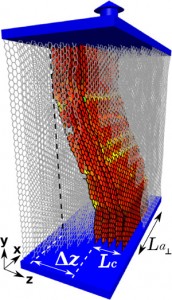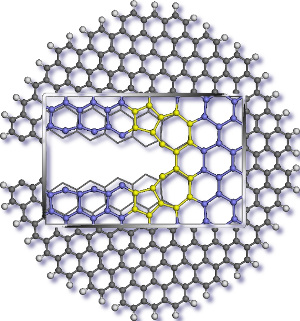A recent work from the group on atomistic modeling of carbon fibers appears in the quarterly Editor’s Highlights for Carbon. These articles are handpicked by the Editors for the reader community and are made freely available for a limited time.
 Carbon fiber structure is excessively complex and modeling attempts necessarily rely on various approximations. We have designed structural faults with atomistic details, pertaining to polyacrylonitrile (PAN) derived fibers, and probed them using large-scale molecular dynamics simulations to uncover trends and gain insight into the effect of local structure on the strength of the basic structural units (BSUs) and the role of interfaces between regions with different degrees of graphitization. Besides capturing the expected strength degrading with increasing misalignment, the designed basic structural units reveal atomistic details of local structural failure upon tensile loading.
Carbon fiber structure is excessively complex and modeling attempts necessarily rely on various approximations. We have designed structural faults with atomistic details, pertaining to polyacrylonitrile (PAN) derived fibers, and probed them using large-scale molecular dynamics simulations to uncover trends and gain insight into the effect of local structure on the strength of the basic structural units (BSUs) and the role of interfaces between regions with different degrees of graphitization. Besides capturing the expected strength degrading with increasing misalignment, the designed basic structural units reveal atomistic details of local structural failure upon tensile loading.
The image shows an atomistic representation of a BSU (~ 40,000 atoms); for clarity part of the geometry is not rendered. A misoriented block is highlighted. Load is applied along the fiber axis, as indicated by the thick arrow, by displacing thin slabs (“handles”) at the top and bottom of the system, schematically represented as plates.



